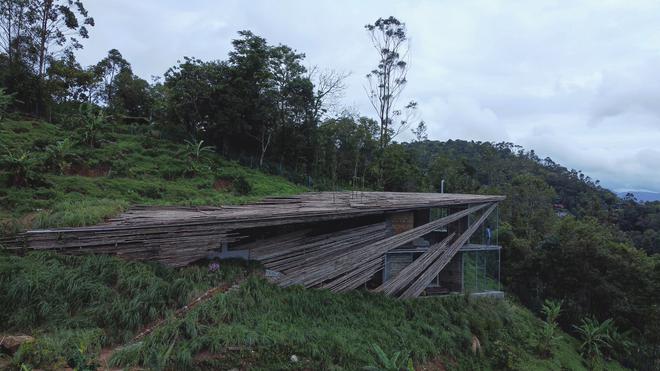When it comes to a residence, there are certain standard expectations to meet the exacting demands of a contemporary lifestyle. While contextual resonance is welcomed, the built expanse is still expected to be conventional in approach, without which the comfort desired is oft perceived to get diluted. Yet, architect Vinu Daniel of Wallmakers comes up with designs and construction methodologies for his residential projects where the approach is not only totally unconventional, but the emerging edifice is so in tune with its context as to leave the least footprint.
His recent projects, Shikhara House, The Ledge, and The Debris House, are classic examples of this, where the totally unconventional approach has put up unique yet cheerful residences with a sustainable quotient in each reigning high. All of Daniel’s projects are incidentally executed after long sojourns at the site where the multiple possible alternative approaches are explored and experimented by physically being present through the entire construction process.
Slanted to shield
The Shikara House is no exception, featuring as it does on the edge of a remote hilltop surrounded by dense vegetation. The language opted in design is visibly brutal, even harsh, to resonate with the direct onslaught of the western sun on the west facing site. Thus, a slanted shuttered debris wall serves as a literal shield against this harsh western sun, protecting the interiors from direct heat ingress. “The design resonates with the natural tendency to use a shield to shade when faced with direct harsh sunlight.
The inclined opaque facade does just that, shield against the western sun,” explains Daniel. The shuttered debris wall is incidentally patented by Daniel where construction debris is used along with cement and mud. “The site conditions dictated this choice as the terrain was rocky and the soil from the site was unsuitable for making CSEBs as they were full of pebbles and debris”, he points out. The structure is designed as a meeting of two triangles, with a basement, ground floor and first level where all three storeys are built using the shuttered debris wall.

Aluminium coin sheets and acute spaces
While the slanting façade works excellently to shield the interiors from heat ingress, the interior spaces become acute because of the presence of the triangular shape and slant. But Daniel turned this to advantage, given a side wall opening up and removing the constricted feeling inside. A triangular courtyard features in the living area which exits into the rest of the residence.
The option of a blank wall on the western side with only small openings threw up the challenge of cross-ventilation. It was successfully solved by incorporating aluminium coin sheets that come with perforations. “A rhythmic undulating pattern was worked on the inclined façade with the aluminium coin sheets permitting ample natural light and ventilation besides enabling a peek into the exteriors. They also serve as the staircase, going up to the attic”, elaborates Daniel. Cement fibre boards serve as staircase treads and interior bridges.
The residence comes with a terrace that harbours select isolated spots designed explicitly to allow privacy and reflection in solitude against the backdrop of the mountains. Grey and white oxide finish the floors and select portions of the walls, with the entire furniture having been made from scrap pieces of cut wood.
Camouflaged with Casuarina
His project, The Ledge, is no different in its design address, featuring as it does, on top of a hill in Peeramedu, Kerala. Perched on the edge of the hill, the structure protrudes with its pointed triangular roof thrusting forward into the thin air of the expansive valley. The treated poles of the swiftly growing Casuarina tree, considered waste and used only for scaffolding and fencing, cover the exterior glass walls and the Ferro cement composite roof.
The central courtyard of the residence features a set of Casuarina trees to support the Ferro cement composite roof. The Casuarina poles placed over the roof are staggered at different levels to double up as tables and benches for an outdoor party area. “The idea was to ensure the structure blends seamlessly into its environs even as the functional needs of a home are successfully met within the building”, explains Daniel on the intent to camouflage the structure using the Casuarina poles. “The poles also facilitate a natural vegetation cover, successfully covering the structure eventually to become an undistinguishable segment of the hills.”
While the exterior glass walls of the residence permit unhindered views of the valley and hills beyond, lending the feel of aboding on the edge of a precipice, his patented shuttered debris walls serve as the demarcating interior walls for the functional zones. Small rocks sourced during the site excavation were infused into the debris wall along with mud and waste to lend a unique pattern. A collage of scrap cable trays serve as grills for windows, waste wood pieces fuse into the flooring, and discarded elements such as a boat become unique furniture pieces.
The 2,000 sq.ft residence comes with a Jacuzzi and a comforting fireplace, permitting the comforts of a modern residence even as the glass walls, free-flowing breeze, and unhindered visual connection to the mighty hills beyond remind one of abounding nature.
Patenting the shuttered debris wall
When Daniel was given the task of designing the Debris House, he noticed the site filled with construction debris dumped by neighbouring residences. The quantum of debris that confronted him prompted him to patent his shuttered debris wall, where he built the walls using a mixture of the earth excavated from the site and the construction debris. He executed the debris walls first time in the Debris House, where an artistic curvilinear debris wall carves out an internal courtyard, the sky-lit area becoming the central focus of the interiors.
Not only are the walls made from construction waste, but the interiors also, with discarded wood repurposed into furniture and salvaged meter boxes from the local scrapyard, offering an artistic shield to the windows, enabling a dynamic play of light and shadow through the day. Copious natural light and ventilation prevail in the interiors, given the intelligent structuring of the courtyard, windows and the façade. Rammed earth walls, made from mud sourced from the site, filler slab roof with coconut shells, wastewater recycling, and rainwater harvesting further add to the strong green quotient.







